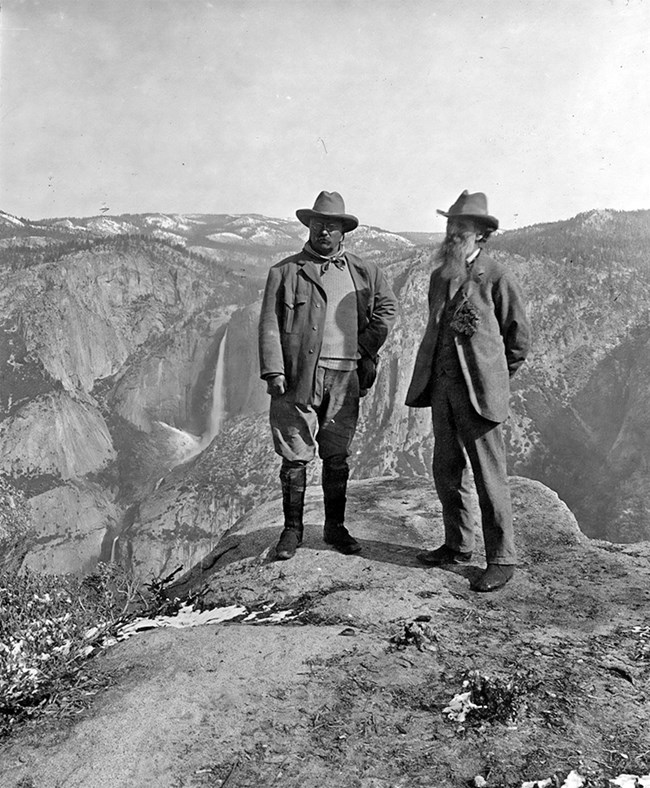
Library of Congress Historic Visit to YosemiteIn 1903, Roosevelt visited Muir in Yosemite. Guided into the Yosemite wilderness by naturalist John Muir, the president went on a three-day wilderness trip that started at the Mariposa Grove, and included Sentinel Dome, Glacier Point, and Yosemite Valley among other points of interest in Yosemite National Park. Muir seized the opportunity "to do some forest good in talking freely around the campfire," and the President, referring to John Muir, is quoted as saying "Of course of all the people in the world, he was the one with whom it was best worthwhile thus to see the Yosemite." Roosevelt and Muir camped the first night, May 15, at the Mariposa Grove under the Grizzly Giant, with the President bedding down in a pile of about 40 wool blankets, and the second night was spent in the vicinity of Sentinel Dome during a snowstorm that left five inches of new snow on top of the existing five feet of snow. The third night of camping was at the edge Bridalveil Meadow in Yosemite Valley, where President Roosevelt was Muir's captive audience to hear a convincing plea for Yosemite wilderness and for setting aside other areas in the United States for park purposes. That night, during the campfire discussion, Muir's main focus of conversation was not only the need for forest preservation but also his concern that the California State Grant of Yosemite Valley and the Mariposa Grove, surrounded in 1892 by Yosemite National Park, be receded to the United States for inclusion in the park. Roosevelt agreed that two controls made for "triple troubles." Eventually, their discussion prompted the Presidential signature on the Yosemite Recession Bill in June 1906. This Joint Resolution accepted the recession by the State of California of the Yosemite Valley Grant and the Mariposa Big Tree Grove, now the Mariposa Grove of Giant Sequoias, which withdrew them from state protection and put them under federal protection, making them part of Yosemite National Park. "There can be nothing in the world more beautiful than the Yosemite, the groves of the giant sequoias...our people should see to it that they are preserved for their children and their Children's children forever, with their majestic beauty all unmarred," said Theodore Roosevelt. During his presidency, Theodore Roosevelt signed into existence five national parks, 18 national monuments, 55 national bird sanctuaries and wildlife refuges, and 150 national forests (Source for forgoing: "100th Anniversary of President Theodore Roosevelt and Naturalist John Muir's Visit at Yosemite National Park" - National Park Service Press Release (May 15, 2003). Frequently Asked Questions1. When did Theodore Roosevelt visit John Muir in Yosemite? 2. What was the purpose of Roosevelt’s trip to Yosemite? 3. How long did the trip last, and where did they go? 4. Where did Roosevelt and Muir camp each night?
5. What topics did Muir and Roosevelt discuss during the trip? 6. What was the outcome of their discussions? 7. What did Roosevelt say about his experience in Yosemite? 8. What was Theodore Roosevelt’s legacy in conservation?
9. How did the Yosemite trip influence Roosevelt’s conservation policies? 10. Why was the Yosemite Recession Bill significant? 11. What quote demonstrates Roosevelt’s admiration for John Muir? Additional Information12. What hardships did they encounter during the trip? 13. What artifacts or locations commemorate their trip today? |
Last updated: December 19, 2024
